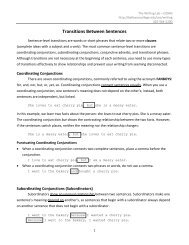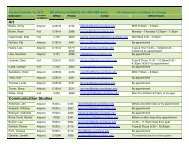The Compare-Contrast Essay: What it is and ... - Bellevue College
The Compare-Contrast Essay: What it is and ... - Bellevue College
The Compare-Contrast Essay: What it is and ... - Bellevue College
Create successful ePaper yourself
Turn your PDF publications into a flip-book with our unique Google optimized e-Paper software.
<strong>The</strong> <strong>Compare</strong>-<strong>Contrast</strong> <strong>Essay</strong>:<br />
<strong>What</strong> <strong>it</strong> <strong>is</strong> <strong>and</strong> How to Construct One<br />
<strong>The</strong> Wr<strong>it</strong>ing Lab – D204d<br />
http://bellevuecollege.edu/asc/wr<strong>it</strong>ing<br />
425-564-2200<br />
A compare/contrast essay looks at two or more things to find meaningful similar<strong>it</strong>ies or<br />
differences between them. Comparing things explores aspects that are similar, <strong>and</strong> contrasting d<strong>is</strong>cusses<br />
differences. By analyzing common parts of different things, readers should get a deeper underst<strong>and</strong>ing<br />
of them.<br />
Although they have many different names, the two main approaches to a compar<strong>is</strong>on essay are<br />
block style <strong>and</strong> point-by-point style. <strong>The</strong> block approach explains aspects of one topic in one paragraph,<br />
then compares or contrasts the same kinds of things about the other topic in the next paragraph. For<br />
instance, you may describe Movie A's setting, dialogue, <strong>and</strong> music, then describe Movie B's setting,<br />
dialogue, <strong>and</strong> music in relation to Movie A. In the point-by-point style, one point or aspect of both topics<br />
<strong>is</strong> d<strong>is</strong>cussed, identifying their differences <strong>and</strong> similar<strong>it</strong>ies in one or two paragraphs, before moving on to<br />
explore the next point of compar<strong>is</strong>on. <strong>The</strong> block organization <strong>is</strong> easier to follow for short essays, while<br />
the point-by-point approach <strong>is</strong> better su<strong>it</strong>ed to longer, more complex papers (Comprone 275; Fawcett<br />
123-124). <strong>The</strong> conclusion of both styles of compar<strong>is</strong>on sums up the similar<strong>it</strong>ies <strong>and</strong> differences d<strong>is</strong>cussed<br />
<strong>and</strong> evaluates them.<br />
W<strong>it</strong>h any compar<strong>is</strong>on essay, brainstorming <strong>and</strong> prewr<strong>it</strong>ing are especially helpful to prevent<br />
shallow or circular wr<strong>it</strong>ing. Make a l<strong>is</strong>t or diagram to find common parts to compare, then figure out<br />
how those common parts are similar <strong>and</strong> different, <strong>and</strong> what effects they have on you as an audience<br />
member or on the subjects themselves. In the prewr<strong>it</strong>ing stage, <strong>it</strong> may become clear that the topics of<br />
compar<strong>is</strong>on are very similar, so focusing on their differences could be necessary to develop the essay.<br />
Likew<strong>is</strong>e, if the topics seem completely unlike each other at first glance, d<strong>is</strong>cussing their hidden<br />
similar<strong>it</strong>ies may prove more interesting (Fawcett 284). Making these kinds of dec<strong>is</strong>ions before drafting<br />
the essay can keep the compar<strong>is</strong>on focused.<br />
As the compar<strong>is</strong>on progresses, a deeper impression of the topics should develop through<br />
analys<strong>is</strong>. Go beyond a mere l<strong>is</strong>ting of differences to explain, for example, why the characters see the<br />
world differently, or why one argument <strong>is</strong> more effective than another. Conclude w<strong>it</strong>h a brief review of<br />
the subjects compared, reminding readers of the reasons the similar<strong>it</strong>ies <strong>and</strong> differences are important.<br />
Some useful trans<strong>it</strong>ion words <strong>and</strong> phrases include the following:<br />
Similar<strong>it</strong>ies: as, in add<strong>it</strong>ion, likew<strong>is</strong>e, similarly, moreover, also, too, in a similar way/vein/fashion,<br />
both, ne<strong>it</strong>her, just as...so, like, the same;<br />
Differences: although, whereas, conversely, in contrast, on (the) one h<strong>and</strong> . . . on the other<br />
h<strong>and</strong>, however, unlike, but, yet, instead, on the contrary.<br />
Works C<strong>it</strong>ed<br />
Comprone, Joseph J. Form <strong>and</strong> Substance: <strong>The</strong> Modern <strong>Essay</strong>. Dubuque: Brown, 1976.<br />
Fawcett, Susan <strong>and</strong> Alvin S<strong>and</strong>berg, eds. Evergreen w<strong>it</strong>h Readings. Boston: Houghton Mifflin, 1996.
Cigar Trees <strong>and</strong> Faux Firs<br />
(A Block-Style Compar<strong>is</strong>on)<br />
Cone-bearing trees appear so different from broadleaf trees that they don’t seem to have anything in<br />
common other than being trees. Given their d<strong>is</strong>similar<strong>it</strong>y, finding elements in common <strong>is</strong> all the more striking. <strong>The</strong><br />
coniferous Douglas-fir <strong>and</strong> the broadleaf catalpa are different in fru<strong>it</strong>, leaf, <strong>and</strong> evolutionary age. However, both<br />
trees can be seen on the BCC campus, have similar species variety, <strong>and</strong> add to the health of the environment.<br />
<strong>The</strong> Douglas-fir <strong>is</strong> not a true fir, but a d<strong>is</strong>tinct species w<strong>it</strong>h two varieties, Coast <strong>and</strong> Rocky Mountain. It<br />
gets <strong>it</strong>s official name, Pseudotsuga menziesii, from Archibald Menzies, a Scott<strong>is</strong>h natural<strong>is</strong>t who d<strong>is</strong>covered the tree<br />
on Vancouver Isl<strong>and</strong> in 1791 (pseudo means “false” <strong>and</strong> tsuga <strong>is</strong> “hemlock”). <strong>The</strong> common name <strong>is</strong> from David<br />
Douglas, the Scott<strong>is</strong>h botan<strong>is</strong>t who identified the tree in the Pacific Northwest in 1826 (“Douglas Fir”). Unlike a true<br />
fir, which has upright cones, the fru<strong>it</strong> of the Douglas-fir <strong>is</strong> a downward-hanging cone that <strong>is</strong> three to four inches long<br />
at matur<strong>it</strong>y. It has rounded scales, <strong>and</strong> between them are three-pronged bracts that look like tiny green bookmark<br />
ribbons that turn brown when the seeds ripen. Seventeen months after the cones first emerge as buds, the seeds<br />
mature <strong>and</strong> are shed in autumn (Williams; Hermann & Lavender). Coast Douglas-fir leaves are flat, yellow<strong>is</strong>h green<br />
1" needles; the Rocky Mountain needles are blu<strong>is</strong>h green; <strong>and</strong> both varieties' needles sprout out all over the branches<br />
(Williams). Douglas-fir <strong>is</strong> also a very old species. Fossils of the Rocky Mountain variety were found in Idaho from<br />
the Rupelian layer of 28.5 to 33.9 million years ago (Paleobiology; Rohde), although fossils of the genus<br />
Pseudotsuga have been found from 50 million years ago (Williams). Th<strong>is</strong> makes sense, since conifers in general<br />
evolved long before fru<strong>it</strong>ing broadleaf trees. Subsequently, any kind of catalpa would have to be a younger species<br />
than Douglas-firs, but that doesn't mean they're completely d<strong>is</strong>similar.<br />
<strong>The</strong> catalpa tree derives <strong>it</strong>s name from “catawba,” the Cherokee word for wood (Brown), <strong>and</strong> has two main<br />
species of tree, the Common or Southern Catalpa whose first publ<strong>is</strong>hed description dates from 1788, <strong>and</strong> the<br />
Northern or Western Catalpa, both originating from eastern North America (Graves). Instead of cones, the catalpa's<br />
fru<strong>it</strong>s are 8"- to 18"-long, narrow green pods that emerge from wh<strong>it</strong>e flowers in the summer. <strong>The</strong> pods ripen <strong>and</strong> turn<br />
brown, resembling cigars, <strong>and</strong> they stay on the tree through autumn <strong>and</strong> winter (Graves). In the spring, the pods<br />
release hundreds of t<strong>is</strong>sue-thin winged seeds that l<strong>it</strong>ter the ground like confetti before falling off the tree. Another<br />
difference between Douglas-fir <strong>and</strong> catalpa trees <strong>is</strong> their leaves. <strong>The</strong> catalpa's medium green leaves are large <strong>and</strong><br />
heart-shaped. Northern Catalpa leaves oppose each other on the stem, but the Southern Catalpa leaves usually<br />
emerge three at a time around the same spot (Michigan). Common among all the trees, both Douglas-fir <strong>and</strong> catalpa,<br />
<strong>is</strong> the fact their leaves are lighter on their undersides. <strong>The</strong> most subtle difference, however, between the Douglas-fir<br />
<strong>and</strong> Catalpa <strong>is</strong> their evolutionary age. Surpr<strong>is</strong>ingly, fossils of Northern Catalpa were found in Oregon from roughly<br />
the same stage as the Douglas-fir fossils found in Idaho (Paleobiology). <strong>The</strong>refore, the Northern <strong>and</strong> Southern<br />
Catalpa may have become d<strong>is</strong>tinct species during the same period of time as the two varieties of the older species<br />
Douglas-fir developed.
Although their outward appearance <strong>is</strong> qu<strong>it</strong>e different, the Douglas-fir <strong>and</strong> Catalpa do have similar<strong>it</strong>ies.<br />
<strong>The</strong>y each developed two kinds, e<strong>it</strong>her varieties of a species or two unique North American species, over a similar<br />
span of time. <strong>The</strong>ir seeds also mature over several seasons, <strong>and</strong> their fru<strong>it</strong>s turn brown before falling from the tree.<br />
Desp<strong>it</strong>e their different origins, these trees have been found growing close to each other in Western Washington,<br />
absorbing no<strong>is</strong>e <strong>and</strong> carbon dioxide, <strong>and</strong> producing oxygen, thereby benef<strong>it</strong>ing us all.<br />
Cigar Trees <strong>and</strong> Faux Firs<br />
(A Point-by-Point Compar<strong>is</strong>on)<br />
Cone-bearing trees appear so different from broadleaf trees that they don't seem to have anything in<br />
common other than being trees. Given their d<strong>is</strong>similar<strong>it</strong>y, finding elements in common <strong>is</strong> all the more striking. <strong>The</strong><br />
coniferous Douglas-fir <strong>and</strong> the broadleaf catalpa are different in fru<strong>it</strong>, leaf, <strong>and</strong> evolutionary age. However, both<br />
trees can be seen on the BCC campus, have similar species variety, <strong>and</strong> add to the health of the environment.<br />
<strong>The</strong> official identifications of the Douglas-fir <strong>and</strong> the catalpa both date from the late 18th century. Desp<strong>it</strong>e<br />
<strong>it</strong>s name, the Douglas-fir <strong>is</strong> not a true fir, but a d<strong>is</strong>tinct species w<strong>it</strong>h two varieties, Coast <strong>and</strong> Rocky Mountain. It gets<br />
<strong>it</strong>s official name, Pseudotsuga menziesii, from Archibald Menzies, a Scott<strong>is</strong>h natural<strong>is</strong>t who d<strong>is</strong>covered the tree on<br />
Vancouver Isl<strong>and</strong> in 1791 (pseudo means “false” <strong>and</strong> tsuga <strong>is</strong> “hemlock”). <strong>The</strong> common name <strong>is</strong> from David<br />
Douglas, the Scott<strong>is</strong>h botan<strong>is</strong>t who identified the tree in the Pacific Northwest in 1826 (“Douglas Fir”). Catalpa<br />
derives <strong>it</strong>s name from “catawba,” the Cherokee word for wood (Brown), <strong>and</strong> has two main species of tree, the<br />
Common or Southern Catalpa whose first publ<strong>is</strong>hed description dates from 1788, <strong>and</strong> the Northern or Western<br />
Catalpa, both originating from eastern North America (Graves).<br />
Unlike the catalpa, the fru<strong>it</strong> of the Douglas-fir <strong>is</strong> a downward-hanging cone that <strong>is</strong> three to four inches long<br />
at matur<strong>it</strong>y. It has rounded scales <strong>and</strong> between them are three-pronged bracts that look like tiny bookmark ribbons;<br />
they go from green to brown as they ripen. Seventeen months after the cones first emerge as buds, the seeds mature<br />
<strong>and</strong> are shed in autumn (Williams; Hermann & Lavender). <strong>The</strong> catalpa’s fru<strong>it</strong>s, on the other h<strong>and</strong>, are 8"- to 18"-<br />
long, narrow green pods that emerge from wh<strong>it</strong>e flowers in the summer. <strong>The</strong> pods ripen <strong>and</strong> turn brown, resembling<br />
cigars, <strong>and</strong> they stay on the tree through autumn <strong>and</strong> winter (Graves). In the spring, the pods release hundreds of<br />
t<strong>is</strong>sue-thin winged seeds that l<strong>it</strong>ter the ground like confetti before falling off the tree.<br />
Another difference between Douglas-fir <strong>and</strong> catalpa trees <strong>is</strong> their leaves. Coast Douglas-fir leaves are flat,<br />
yellow<strong>is</strong>h green 1" needles, <strong>and</strong> the Rocky Mountain needles are blu<strong>is</strong>h green. Both varieties’ needles sprout out all<br />
over the branches (Williams). <strong>The</strong> catalpa’s medium green leaves are large <strong>and</strong> heart-shaped. Northern Catalpa<br />
leaves oppose each other on the stem, but the Southern Catalpa leaves usually emerge three at a time around the<br />
same spot (Michigan). Common among all the trees <strong>is</strong> the fact their leaves are lighter on their undersides.<br />
<strong>The</strong> most subtle difference, however, between the Douglas-fir <strong>and</strong> Catalpa <strong>is</strong> their evolutionary age.<br />
Fossilized Douglas-fir of the Rocky Mountain variety was found in Idaho from the Rupelian layer of 28.5 to 33.9
million years ago (Paleobiology; Rohde), although fossils of the larger group Pseudotsuga have been found from 50<br />
million years ago (Williams). Surpr<strong>is</strong>ingly, fossils of Northern Catalpa were found in Oregon from roughly the same<br />
stage (Paleobiology). <strong>The</strong>refore, the Northern <strong>and</strong> Southern Catalpa may have become d<strong>is</strong>tinct species during the<br />
same period of time as the two varieties of the older species Douglas-fir developed.<br />
Although their outward appearance <strong>is</strong> qu<strong>it</strong>e different, the Douglas-fir <strong>and</strong> Catalpa do have similar<strong>it</strong>ies.<br />
<strong>The</strong>y each developed two kinds, e<strong>it</strong>her varieties of a species or two unique North American species, over a similar<br />
span of time. <strong>The</strong>ir seeds also mature over several seasons, <strong>and</strong> their fru<strong>it</strong>s turn brown before falling from the tree.<br />
Desp<strong>it</strong>e their different origins, these trees have been found growing close to each other in Western Washington,<br />
absorbing no<strong>is</strong>e <strong>and</strong> carbon dioxide, <strong>and</strong> producing oxygen, thereby benef<strong>it</strong>ing us all.<br />
Works C<strong>it</strong>ed<br />
Brown, Beverly. “Catalpa.” Nazareth <strong>College</strong> North <strong>and</strong> South Campus Tree Walks. 4 Dec. 2003. Nazareth <strong>College</strong><br />
of Rochester. http://www-pub.naz.edu:9000/~treewalk/catalpa/catalpa.htm 14 July 2004.<br />
“Douglas Fir & Western Larch.” May 2002. Western Wood Products Association. http://www.wwpa.org/dfir.htm<br />
14 July 2004.<br />
Graves, Emily. “Catalpa.” Univers<strong>it</strong>y of Georgia. http://www.d<strong>is</strong>coverlife.org/nh/tx/Plantae/Dicotyledoneae/<br />
Bignoniaceae/Catalpa/speciosa. 4 Aug. 2004.<br />
Catalpa bignonoides. Univers<strong>it</strong>y of Georgia. http://www.d<strong>is</strong>coverlife.org/nh/tx/Plantae/Dicotyledoneae/<br />
Bignoniaceae/Catalpa/speciosa/bignonoides 4 Aug. 2004.<br />
Hermann, Richard K, Den<strong>is</strong> P. Lavender. “Douglas-Fir.” Silvics of North America Volume 1. 1990. USDA Forest<br />
Service Northeastern Area. http://www.na.fs.fed.us/spfo/pubs/silvics_manual/Volume_1/pseudotsuga/<br />
menziesii.htm. 14 July 2004.<br />
Michigan State Univers<strong>it</strong>y Extension. “Southern Catalpa.” Treehelp.com.TreeHelp Ltd.<br />
http://www.treehelp.com/trees/catalpa/catalpa-types-southern.asp 14 July 2004.<br />
Paleobiology Database, <strong>The</strong>. [search engine]. http://paleodb.org/cgi-bin/<br />
bridge.pl?user=Guest&action=beingTaxonInfo 26 Sep. 2004.<br />
Rohde, Robert. “Geologic Timeline w<strong>it</strong>h Stages.” GeoWhen Database. 25 Mar. 2004.<br />
http://www.stratigraphy.org/geowhen/timelinestages.html 4 Aug. 2004.<br />
Williams, Jordin A. “Biogeography of Douglas-fir (Pseudotsuga menziesii).” Fall 2000. San Franc<strong>is</strong>co State<br />
Univers<strong>it</strong>y. http://bss.sfsu.edu:224/courses/Fall00Projects/Douglas-fir.html 4 Aug. 2004.

















